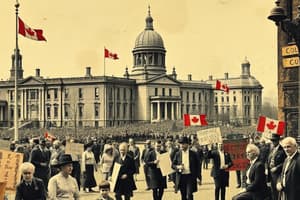Podcast
Questions and Answers
What global conflict saw France and Britain fighting each other in North America?
What global conflict saw France and Britain fighting each other in North America?
- The Napoleonic Wars
- The War of the Roses
- The Hundred Years' War
- The Seven Years' War (correct)
When did the Battle of the Plains of Abraham take place?
When did the Battle of the Plains of Abraham take place?
- 1756
- 1760
- 1759 (correct)
- 1763
What was the outcome of the Battle of the Plains of Abraham?
What was the outcome of the Battle of the Plains of Abraham?
- No clear winner
- British victory (correct)
- French victory
- Stalemate
What did the Treaty of Paris in 1763 lead to?
What did the Treaty of Paris in 1763 lead to?
What was an important result of the end of the Seven Years War?
What was an important result of the end of the Seven Years War?
What event indirectly led to the outbreak of the American Revolution in 1775?
What event indirectly led to the outbreak of the American Revolution in 1775?
What was the outcome of the Treaty of Paris in relation to Canadian identity and borders?
What was the outcome of the Treaty of Paris in relation to Canadian identity and borders?
What did the Quebec Act of 1774 provide to the people in Quebec?
What did the Quebec Act of 1774 provide to the people in Quebec?
How did the Seven Years' War influence Canadian society?
How did the Seven Years' War influence Canadian society?
What role did the conflict between French and British play in shaping Canadian society?
What role did the conflict between French and British play in shaping Canadian society?
Flashcards
Seven Years' War
Seven Years' War
A significant global conflict that occurred from 1756 to 1763, involving France and Britain fighting for control of North America, with the assistance of Indigenous allies.
Battle of Quebec
Battle of Quebec
A pivotal battle fought in September 1759, where the British decisively defeated the French forces under the Marquis de Montcalm, marking a turning point in the control of New France.
Treaty of Paris (1763)
Treaty of Paris (1763)
The 1763 treaty that formally ended the Seven Years' War, marking the end of French control over New France and solidifying British dominance in North America.
New France
New France
Signup and view all the flashcards
Bicultural Nation
Bicultural Nation
Signup and view all the flashcards
Quebec Act (1774)
Quebec Act (1774)
Signup and view all the flashcards
Impact of the Seven Years' War
Impact of the Seven Years' War
Signup and view all the flashcards
Bilingualism
Bilingualism
Signup and view all the flashcards
Cession
Cession
Signup and view all the flashcards
Long-term Impact
Long-term Impact
Signup and view all the flashcards
Study Notes
French and British Conflict in Canadian History
The conflict between France and Britain in Canadian history can be traced back to the early 18th century. The Seven Years' War (1756-1763) was a global conflict that saw both nations fighting each other in North America, with the help of Indigenous allies. The war had significant effects on the political landscape of Canada, leading to the formal cession of New France to the British with the Treaty of Paris in 1763.
KeyEvents in the Conflict
-
Battle of Quebec (1759): The British-French conflict in North America began with the Seven Years' War. The Battle of Quebec, fought in September 1759, was a decisive British victory over the French under the Marquis de Montcalm. This battle marked a turning point in the history of New France and eventually led to British control over Canada.
-
Treaty of Paris (1763): Following the defeat of the French forces at the Battle of Quebec, France formally ceded New France, including Quebec and Ile Royale (Cape Breton), to the British. This treaty marked the end of French presence in North America and laid the bicultural foundations of modern Canada.
Impact on Canadian Identity and Borders
The Seven Years' War had a lasting impact on Canadian identity and boundaries. The removal of France as a North American power gave Anglo-American colonists greater confidence, leading indirectly to the outbreak of the American Revolution in 1775. This conflict further influenced Canadian identity and borders, as well as the relationship between Britain and Indigenous peoples living in the region.
The Treaty of Paris also led to the creation of a legally bilingual and bicultural nation, as the British realized that imposing English customs on the French settlers in Quebec was not working. In 1774, the British created the Quebec Act, which gave people in Quebec freedom of religion and the right to use some French laws, marking the beginning of a more harmonious relationship between the two cultures.
Conclusion
The French and British conflict in Canadian history played a significant role in shaping the country's identity and borders. The Seven Years' War, in particular, led to the formal cession of New France to the British and the establishment of a bicultural nation, with French and British influences continuing to shape Canadian society today.
Studying That Suits You
Use AI to generate personalized quizzes and flashcards to suit your learning preferences.




